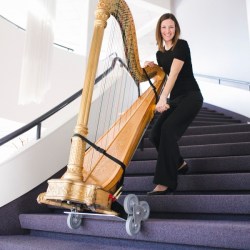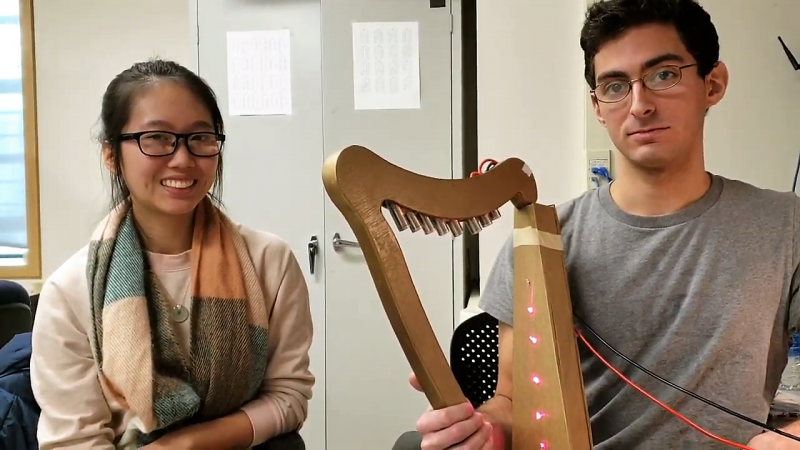The harp is an ancient instrument, but in its current form, it seems so unwieldy that it’s a wonder that anyone ever learns to play it. It’s one thing to tote a rented trumpet or clarinet home from school to practice, but a concert harp is a real pain to transport safely. The image below is unrelated to the laser harp project, but proves that portable harping is begging for some good hacks.

Enter this laser harp, another semester project from [Bruce Land]’s microcontroller course at Cornell. By replacing strings with lasers aimed at phototransistors, [Glenna] and [Alex] were able to create a more manageable instrument that can be played in a similar manner. The “strings” are “plucked” with the fingers, which blocks the laser light and creates the notes.
But these aren’t just any old microcontroller-generated sounds. Rather than simply generating a tone or controlling a synthesizer, the PIC32 uses the Karplus-Strong algorithm to model the vibration of a plucked string. The result is very realistic, with all the harmonics you’d expect to hear from a plucked string. [Alex] does a decent job putting the harp through its paces in the video below, and the write-up is top notch too.
Unique musical instruments like laser harps are far from unknown around these parts. We’ve seen a few that look something like a traditional harp and one that needs laser goggle to play safely, but this one actually looks and sounds like the real thing.
















A different way to play a harp. Camille and Kennerly play Metallica’s “One” on a single harp, and also do a bit of percussion with it. https://www.youtube.com/watch?v=JhOhGhq0e54
I would immagine that the tactile feedback helps a lot in finding the right strings to pluck.
Also, there are different ways to pluck a string. In the middle you get little overtones, while start at the end you do introduce overtones.
I was thinking the same thing about the tactile feedback, as you develop muscle memory when practicing on an instrument. The variations due to different pluck techniques are a good point as well.
use a powerful-enough laser you’ll have your feedback :P
From the title i was expecting some clever processing to get velocity, but this is just on/off
THAT is a laser harp:
https://youtu.be/9DlwQJX3qag?t=53
:-D
Purdue did add a tactile glove to feel the strings on one experiment, I don’t know if it was dynamic but think it was.
Might have done better using strings and piezo pickups. Also, some switches along the base of the harp would allow octive changes. It is not like the strings/lasers are actually making the sound being played. With piezo pickups you could do a few things you can’t do with lasers. One is get the amplitude envelope to lay over the synthesized sound, and second with some clever math on the strings they could determine how many harmonics to add in the synth. Ie if the string was plucked in the middle it would be a more sinusoidal wave, if it was plucked near an end, it would have more harmonics. You could look at a real time fft of the plucked string and determine how much “tweak” to add. It would also allow you to “ping” harmonics on the strings and have that come out through the synth. And having strings would be much more tactile for actually playing the device. Still it was pretty neat, and it sounded pretty good. A few tweaks and they may have a product.
Nice sound, this must be what geeks play in heaven.